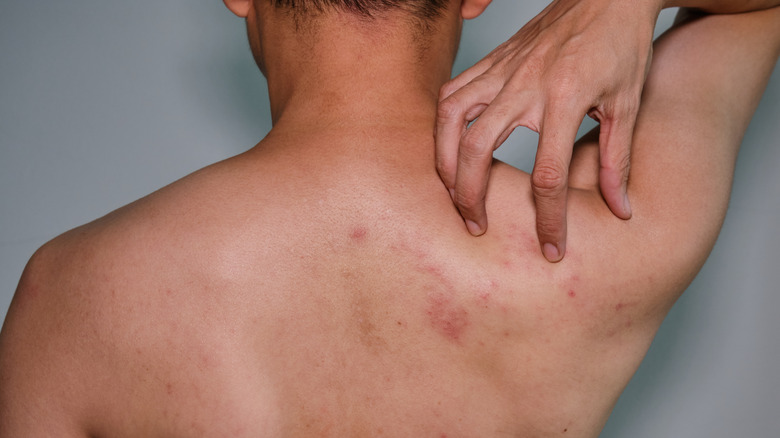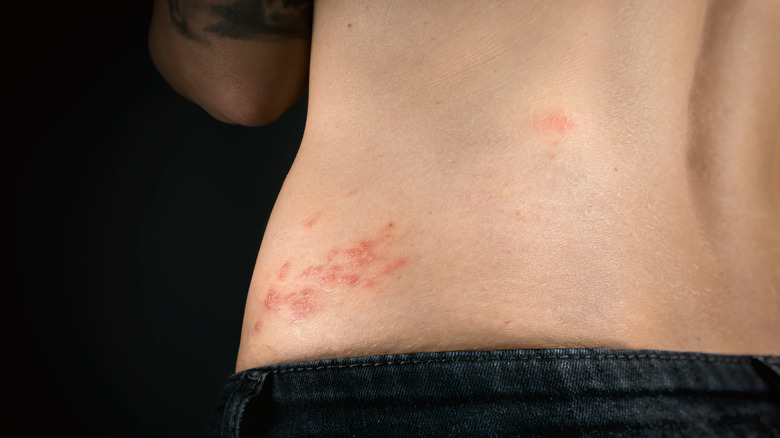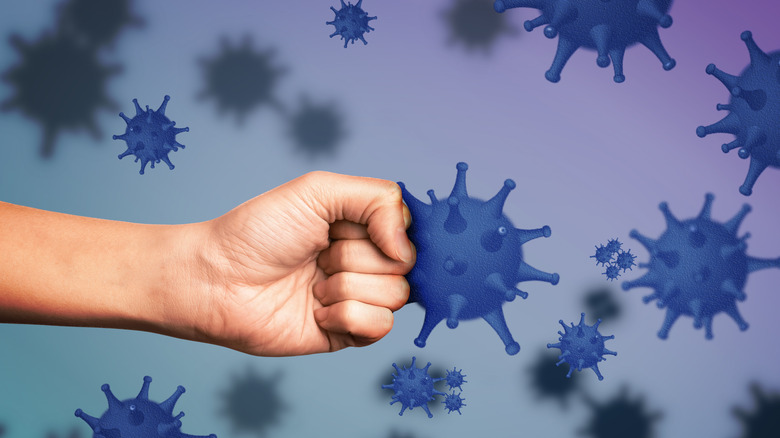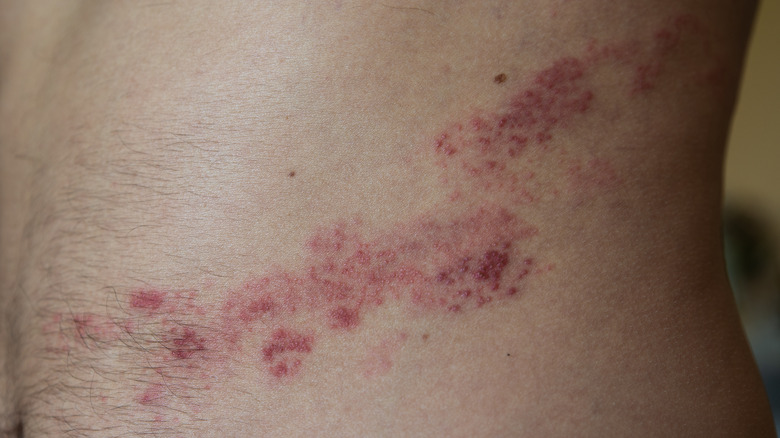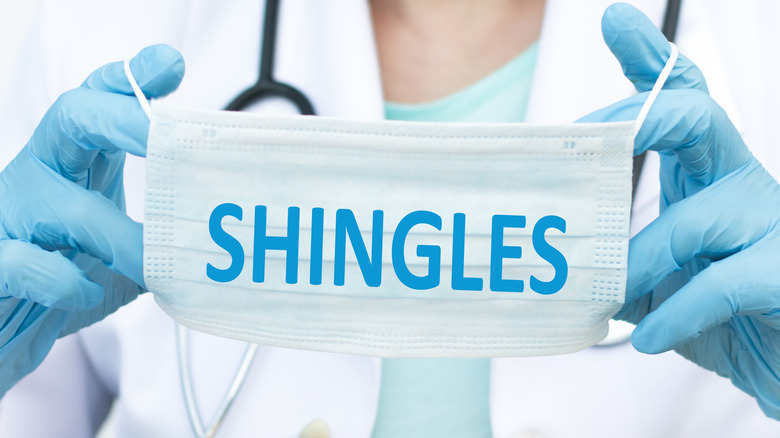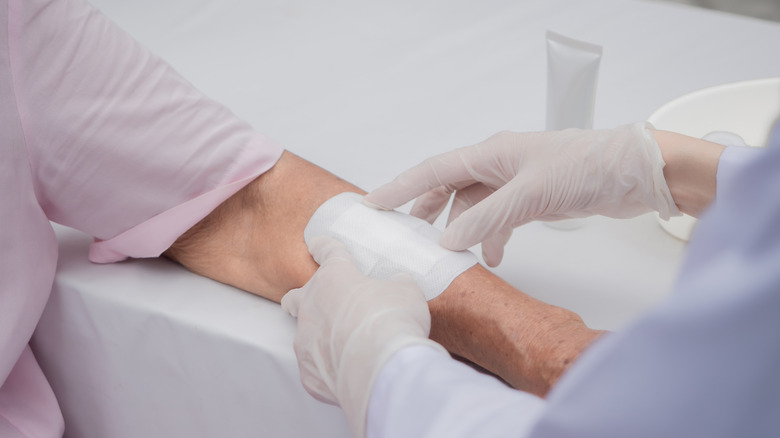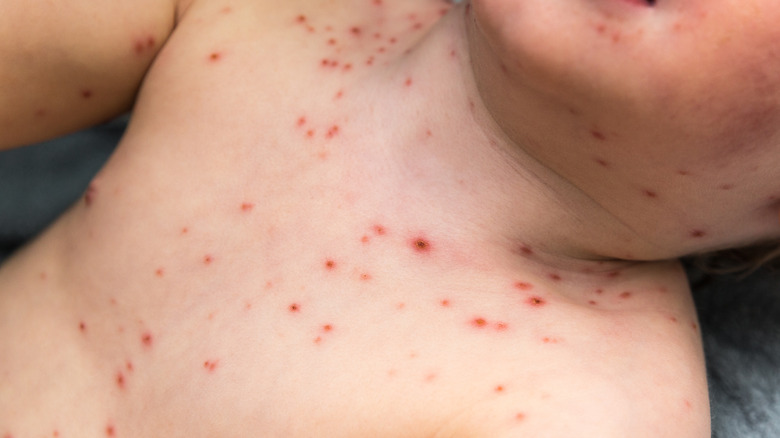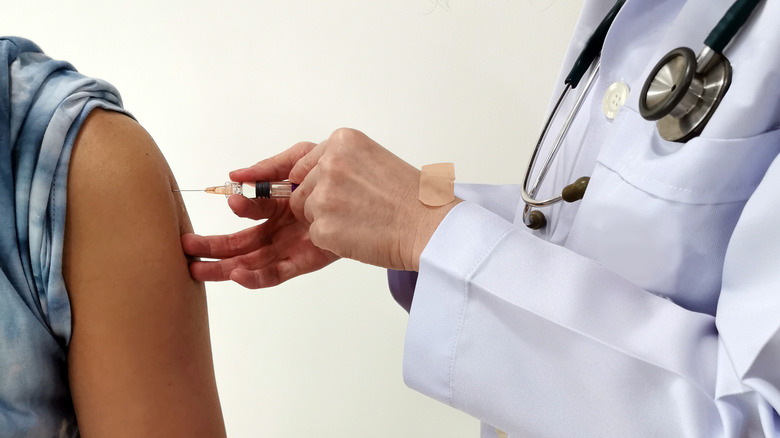Shingles Explained: Symptoms, Causes, And Treatments
Odds are you have heard of shingles — although you may not know much about it. Shingles, or herpes zoster, is an infection of the nerves caused by the varicella-zoster virus, also known as the chickenpox virus, according to the Centers for Disease Control and Prevention. Shingles typically shows up as a painful set of blisters or a rash on your skin. However, this is not always the case. "Shingles symptoms vary in severity and some people can experience shingles pain without ever developing a rash," osteopathic family physician Dr. Rob Danoff told Doctors of Osteopathic Medicine.
Shingles is more common than you might think. The CDC estimates that 1 million people contract shingles every year in the United States, and one in three people will contract shingles in their lifetime. As such, it is important to know what signs to look for, what to expect during recovery, and ways to alleviate your pain efficiently.
Spotting the shingles rash
The shingles rash usually affects one area of your back or chest, but it can also be on other parts of your body. "The virus travels in specific nerves, so you will often see shingles occur in a band on one side of the body. This band corresponds to the area where the nerve transmits signals," the Cleveland Clinic explained. It can even creep down to your buttocks, especially if you have shingles only on one side of the body.
Nevertheless, you can get shingles on your face, mouth, or scalp, all of which can be painful and cause a slew of other health issues (via Healthline). If your rash is near your ear, for example, it can lead to an infection and cause hearing issues. Shingles can also appear in or around your eyes. This can cause blurred vision, burning or throbbing, redness, or swelling, along with other longer-term effects.
The cause
Shingles is the result of the chickenpox virus lying dormant in your body for years, sometimes never even affecting your health. Experts say it's not clear what causes the virus to activate again years later, but "it may happen when something weakens the immune system," according to Medical News Today. When your immune system is working properly and at full effectiveness, your B and T cells can remember the virus from when you had chickenpox and mount a defense quickly (via Harvard Health). But a weakened immune system is not able to do that.
There are factors that can cause your immune system to weaken over time, therefore resulting in a higher risk of shingles down the road. Your age, an autoimmune disorder or virus like HIV, and your genetics are some things you can't really control but can lead to a weaker immune system response. Stress may also play a role (via Healthline).
Shingles can take weeks to heal
Before the shingles rash even shows itself, you might have pain or a burning or tingling feeling on an area of your skin, sometimes described as an "electrical sensation," according to the American Academy of Dermatology Association. Then, the rash appears, usually in a band or patch on one side of your body. The rash progresses into blisters that are red, fluid-filled, and open. Over the course of 10 days, your blisters should start to dry out and scab (via Cleveland Clinic). Those scabs will clear up in about two to three weeks. From start to finish, shingles can last as long as five weeks.
For some people, the painful, blistering rash isn't the only symptom they experience. Other symptoms like chills, enlarged lymph nodes, fatigue, fever, headache, muscle aches, stomach pain, and vomiting are possible. However, they should subside as the rash goes away.
Complications
As if shingles symptoms weren't enough to go through, there are additional complications that this virus may cause after the outbreak is long gone. The Centers for Disease Control and Prevention reports that the most common shingles complication is postherpetic neuralgia, or PHN, which is severe and sometimes debilitating pain in the areas of your shingles rash. In this case, damaged nerves send exaggerated pain messages to your brain, according to the Mayo Clinic.
PHN affects up to 18% of people with shingles. The older the person with shingles is, the higher the risk of PHN. The condition can affect the quality of your sleep, cause weight loss, and interfere with your life (via Houston Methodist). Vision loss and eye infections are also possibilities for those who experienced shingles on or near their eye (via Mayo Clinic). Neurological issues like facial paralysis can also occur, as well as skin infections from the blisters not being treated properly. Other rare complications include brain inflammation, hearing problems, and pneumonia, according to the CDC. Death is also a potential complication, although it is rare.
Risk factors for shingles
Some populations are more likely to experience shingles. Risk factors include age (specifically people older than 50), undergoing cancer treatments, having an autoimmune disorder, or taking steroids like prednisone for a long period of time (via Mayo Clinic). Taking other medications can also lead to a higher risk of a shingles outbreak. People with an organ transplant, advanced psoriatic arthritis, or psoriasis could be more likely to have shingles due to their immune-suppressing medications (via the American Academy of Dermatology Association).
Your lifestyle may also affect the likelihood you get shingles. Stress, trauma, and other illnesses can contribute to the risk factors for shingles, according to the Cleveland Clinic. If you are recovering from a serious injury, your body may be under enough stress to trigger a shingles outbreak (via WebMD).
If you don't fit into any of those categories, you aren't totally in the clear. As the Mayo Clinic confirmed, "Anyone who's had chickenpox may develop shingles."
Stopping transmission
You may be wondering if shingles is contagious like the chickenpox virus. The answer is yes, the virus is contagious — but not in the way you may think. The varicella-zoster virus can be passed to someone who hasn't had chickenpox or the vaccine via fluid from your rash or blisters. However, the virus will cause chickenpox, not specifically shingles (via Centers for Disease Control and Prevention). That means you can't get shingles from someone with shingles, but you could develop shingles at a later date.
There are some steps to prevent transmission of the chickenpox virus. Covering your shingles rash is the main way to keep the virus away from others. You should also avoid scratching the rash and wash your hands to prevent spread. Thankfully, the virus cannot be transmitted before the shingles rash appears nor after the rash starts healing or crusting, according to the CDC. It also isn't an airborne virus, meaning you have to come in direct contact with a rash or blister to catch it (via Healthline).
Until your rash heals, though, it is wise to avoid premature or low birth weight infants, pregnant women who haven't had chickenpox or the vaccine, and those with weak immune systems, per the CDC.
Differences between shingles and chickenpox
"The varicella-zoster virus that initially causes chickenpox can come back to life, so to speak. When it does, it causes a different disease — called herpes zoster, or shingles," Dr. Donald Brown, a primary care practitioner, tells Houston Methodist. "The result is still a rash, but this rash is typically localized to a single area on your skin and is much more painful than the itchy rash you experienced during chickenpox."
Chickenpox typically affects children and is milder than shingles, according to the Association for Professionals in Infection Control and Epidemiology. Chickenpox is also very contagious, whereas shingles cannot directly cause shingles. Chickenpox symptoms include headache, fever, and tiredness before the rash appears. When the rash appears, it typically begins on the face before spreading to the rest of the body. The duration of chickenpox is shorter than a shingles outbreak, typically lasting one week.
Treatment options
Unfortunately, there is no cure for shingles. But there are multiple treatment options to help shorten your outbreak and make your symptoms less intense. Specific treatment options will be based on your age, health, medical history, and your body's tolerance to certain medications or procedures (via Johns Hopkins Medicine).
Timing is especially important. Starting prescription medication within three days of the rash's development can reduce your pain, reduce the virus' duration, and potentially prevent complications like postherpetic neuralgia (via American Academy of Dermatology Association).
Pain can be mitigated with over-the-counter or prescription painkillers. You will likely be prescribed antiviral medications like acyclovir, famciclovir, or valacyclovir. Other medication options may include anticonvulsants, antidepressants, and steroids as needed. Like chickenpox, the itching or discomfort from the rash can be the most irritating and painful part of shingles. Some treatment options for the itching include calamine lotion, colloidal oatmeal baths, and wet, cool compresses (via Centers for Disease Control and Prevention).
Preventing shingles
The good news is there is an easy way to prevent shingles. The Shingrix shingles vaccine is available for adults who are at least 50 years old. It is administered in two doses, two to six months apart, and can protect you against shingles for more than five years (via Mayo Clinic). It boasts at least a 90% success rate at preventing shingles, according to the National Institute on Aging.
Not sure if you've had chickenpox or the chickenpox vaccine? You should still get vaccinated against shingles, according to experts at the National Institute on Aging. Additionally, even if you have had shingles before, it is still recommended to get the Shingrix vaccine. However, if you've had allergic reactions to vaccine ingredients, are breastfeeding or pregnant, are ill with a high fever, or currently have shingles, you should first discuss the vaccine with your medical team (via Cleveland Clinic).
Myths about shingles
You may have heard that only elderly people get shingles. However, this isn't true. While it is rare for people to get shingles before the age of 40, it is possible, according to the American Academy of Dermatology Association. If a younger person is undergoing a large amount of stress or chronic health issues, the immune system may not be able to fight off the shingles virus like it typically would. A younger person's case of shingles could be milder than it would be for an older person (via Healthline).
Another myth you may have believed is that a person cannot get shingles more than once. While it isn't very common, there is still a chance that you'll get shingles a second time. In fact, women are at a higher risk than men of having a secondary shingles outbreak (via Health). Thankfully, the shingles vaccine can reduce the chance that you will get another outbreak, according to Harvard Health.
Managing shingles
So, you have the shingles — now what? You are probably stuck with the itchy, painful rash for at least a couple of weeks. During this time, you should take steps to care for the rash properly, advised the American Academy of Dermatology Association. Each day, you should wash the rash with fragrance-free soap. Next, apply pure petroleum jelly and cover the rash with a nonstick bandage. Don't forget to wash your hands!
It's not just rash care that is needed to get you through your bout of shingles, though. You will want to keep yourself healthy and comfortable both mentally and physically. Getting enough sleep, eating well-rounded meals, and keeping yourself occupied with hobbies can make this time more bearable. You should also avoid stress if at all possible — try yoga or meditation to help with relaxation — and wear loose-fitting clothes to prevent discomfort.
When to see a doctor
If you think you may have shingles, the American Academy of Dermatology Association recommends seeing a doctor as soon as possible — ideally within three days of spotting the rash. Even if your symptoms seem mild, the sooner your doctor can diagnose and treat you for shingles, the sooner you can be on your way to recovery.
"In particular, we want you to come into the office so we can try to reduce your chances of developing PHN [postherpetic neuralgia]," Dr. Donald Brown, a primary care practitioner, tells Houston Methodist. "PHN occurs most frequently in those over the age of 60, and there's evidence that antiviral treatment can reduce a person's risk of developing this complication."
If you have a fever or notice the rash worsening, don't hesitate to call your doctor. And "even if you've already seen your doctor for shingles, you should get medical care right away if the rash starts to spread to your face," ShareCare advised.

